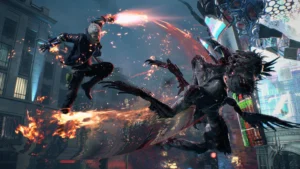RE Engine: Powering Realism, Next-Generation Experiences in Gaming

Introduction
Capcom’s Reach for the Moon-aptly shortened as RE-Engine-has grown to become a big shot in the world of game development. Driving some of the most visually and technically impressive games of the past few years. Known for its leading titles like Resident Evil Village, Devil May Cry 5, and Monster Hunter Rise, the .RE Engine became the yardstick for realism in graphics, fluidity in performance, and storytelling.
In this article, we are going to expose features, novelties, and influence of the RE Engine, showing how this engine empowers developers for quality gameplay creation. Birth and evolution of RE Engine
Origins and Evolution of RE Engine
The RE Engine, first introduced with Resident Evil 7: Biohazard back in 2017, was developed by Capcom with the purpose of making highly detailed, photo-realistic graphics while retaining performance optimized on a wide variety of hardware.
Built to support next-gen consoles, PC, and mobile devices, RE Engine has indeed shown its versatility, evolving through the times with each new challenge and hardware capability.
The RE Engine cross-platform design by default allows for its application on many platforms, from PlayStation through Xbox and the PC line to even the Nintendo Switch.
This ability of cross-development, rather than having to invest resources in developing a new engine for each platform, has allowed Capcom to expand its reach with its triple-A titles to a wider audience without sacrificing quality.
It’s this ongoing evolution that has kept the engine current and competitive in the fast-moving games industry.
Visual Fidelity and Photorealistic Graphics
One of the most striking aspects of the RE Engine is the striking graphics it is capable of generating, along with its special focus on photo-realism.
The marriage of high-resolution textures, effective lighting, and minute details of character models and environments really makes it one of the most realistic graphic incarnations in gaming today.
High-Resolution Textures. RE Engine supports ultra-high-resolution textures that allow for granular surface detail, adding depth both to environments and characters.
This is notably evident in games such as Resident Evil Village, whereby textures bring life into the walls, furniture, and even clothes.
Advanced Lighting and Shading. The engine boasts of dynamic lighting and shadowing, which are the bedrocks of a horror or atmosphere-based game.
This is where immersion and mood need to be just right. Global illumination with soft shadows and real-time reflections makes for quite a realistic ambiance, sending jitters down players’ spines.
Character Details and Animation. Capcom, using the RE Engine, has been able to develop hyper-real facial animations along with fluidic character movement, using high-end motion capture techniques and top-notch animation.
Games such as Devil May Cry 5 can press this for cinematic-quality action scenes filled with life-like and highly expressive characters.


Optimized Performance across Platforms
It is to Capcom’s credit that the RE Engine has remained powerful and efficient, no mean feat considering today’s resource-intensive gaming market. While the engine is capable of creating complex visuals and animations, it is also optimized to maintain high frame rates and smooth gameplay across various platforms-from next-gen consoles to portable systems like the Nintendo Switch.
Diverse Hardware Scalability. The scalability of the game engine-allowing high-fidelity graphics to run with ease on extremely powerful consoles down to smooth performance on underpowered systems-is further evident in how Monster Hunter Rise pushes the limits of the graphical capabilities of the Nintendo Switch as a portable console. The engine makes use of many optimization techniques to fit within the specifications.
Another strong point of RE Engine is efficient memory management, which keeps the performance at the same level. This becomes important in open-world settings where there are a lot of active elements: in case games require big environments and dense asset loading, like Resident Evil Village.
Real-Time Ray Tracing and Lighting Improvements
More recently, with each new update, the RE Engine has been implementing real-time ray tracing that expands the boundaries of visual quality even further. Reflections and lighting can now feel even more realistic with ray tracing, adding much to the atmosphere of both horrors and action scenes.
Ray Tracing-Enhanced Realism. Real-time ray tracing simulates how light interacts with surfaces more accurately compared to the traditional means that could, hence producing accurate and detailed reflections, shadows, and ambient occlusion. This effect is especially noticeable in indoor environments where light bounces off from surfaces, creating realistic shadows.
Ray Tracing in Resident Evil and Devil May Cry. Capcom has implemented ray tracing into the Resident Evil series and Devil May Cry 5: Special Edition on both PlayStation 5 and Xbox Series X. The post-processing effect gives immense depth and realism to graphics, therefore giving these games a look and feel of next-generation titles.
Support for Horror and Action Genres
It feels like with the RE Engine, various talents of Capcom in horror and action genres fall just within the right place. From creating an environment with atmosphere to fluid combats, this engine supports a wide range of mechanics and design elements crucial to such genres.
Dynamic AI and Animation. It allows for complex behaviors of AI; hence, enemies in Resident Evil would be able to react dynamically upon the actions taken by the player. This will enhance the feeling of horror, as enemies can be shown to be far more unpredictable and challenging.
Fast-Motion Combat in Action Titles. The RE Engine can operate with heavy animations and a high frames-per-second rate; hence, it works well in fast-action moves of Devil May Cry 5. Performance optimization within the engine offers smooth combat, detailed particle effects, and responsive controls in the game.

Future of RE Engine: Upcoming Capabilities and Trends
Pretty versatile, Capcom’s RE Engine seems to be very bright for the future. Moving forward, with Capcom continuing to develop new titles and dive into next-generation gaming, the engine will more than likely morph with added support for AI-driven features, better VR capabilities, and a greater depth of immersion.
AI-driven features may include upgrading the RE Engine to the next step in enhancements to AI, catapulting enemies and NPCs to even smarter levels. Better AI means more fluid, dynamic interactions that challenge the player-a great thing in any horror and survival game where strategy is everything.
Stronger VR and AR integrations. As VR continues to grow, RE Engine may well lead the charge in VR and AR integrations. This also opens more opportunities for Capcom to provide even more VR-oriented experiences, especially with the Resident Evil franchise, which already has a very ready VR fanbase.
Cloud Gaming and Remote Play Optimization. With cloud gaming gaining momentum, Capcom could work out an optimization for the RE Engine that would support smooth streaming and remote play, possibly even allowing its titles to reach wider audiences across varied devices and platforms.
Conclusion
The RE Engine has grown into a powerful backbone within Capcom’s arsenal of game development tools, featuring immersive graphics, optimized performance, and engaging gameplay mechanics. From photorealistic visuals and complex character animations to dynamic gameplay support, the RE Engine has shown just how technology can elevate storytelling and player engagement in video games.
With Capcom continuing beyond this point with new projects in the future, it means gamers all over the world are going to experience even more groundbreaking experiences with further evolution of the RE Engine.
For more information visit the Capcom.com website
Don’t forget to check out our other articles gamedevr.site



